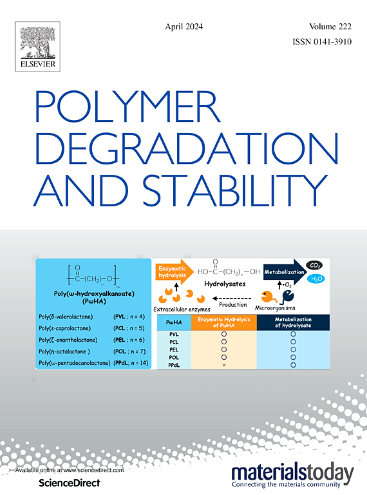确定用于老化 SBS 改性沥青再生的双组分同步再生剂复合材料最佳用量的有效方法
IF 6.3
2区 化学
Q1 POLYMER SCIENCE
引用次数: 0
摘要
使用双组分同步再生剂复合材料(SRC)重新连接断裂的苯乙烯-丁二烯-苯乙烯(SBS)聚合物链并重新平衡老化纯沥青的不稳定胶体结构,对于回收利用废弃的 SBS 改性沥青(SBSMA)混合物至关重要。本研究开发了一种有效的方法,通过恢复傅立叶变换红外光谱峰面积比来确定 SRC 的最佳用量。根据对使用异氰尿酸三烯丙基酯(TAIC)(SBS 修复剂)和芳香油(纯沥青成分调节剂)进行再生的老化 SBSMA 的傅立叶变换红外光谱分析,确定了 TAIC 的最佳用量,即 968 cm-1 处的傅立叶变换红外峰面积比损失完全由 1022 cm-1 和 1112 cm-1 处的新峰面积比补偿,而芳香油的最佳用量则确定为 1376 cm-1 和 1600 cm-1 处的傅立叶变换红外峰面积比损失完全恢复。根据这一原则,制备了七种老化 SBSMA,并加入不同剂量的 TAIC 和芳香油使其恢复活力。通过分析所制备的老化 SBSMA 在同步年轻化前后的傅立叶变换红外峰面积比,发现 TAIC/芳香油的最佳用量与所需的恢复峰面积比之间存在良好的线性关系。分别建立了 yTAIC=1.7852x+0.0229 (R2= 0.9616) 和 y芳香油=2.2809x-0.0109 (R2= 0.9395) 的拟合方程,以确定双组分 SRC 的最佳用量。将理论上得出的 TAIC 和芳香油最佳用量添加到三种老化 SBSMA 中后,发现它们的物理流变学和显微性能恢复到了原始 SBSMA 的 90%左右,验证了新方法的有效性。本文章由计算机程序翻译,如有差异,请以英文原文为准。
An efficient approach to identifying optimum dosages of the two-component synchronous rejuvenator composite for rejuvenating the aged SBS-modified asphalt
Reconnecting fractured styrene-butadiene-styrene (SBS) polymer chains and rebalancing unstable colloidal structures of aged pure asphalt using two-component synchronous rejuvenator composite (SRC) are essential for recycling waste SBS-modified asphalt (SBSMA) mixtures. This research develops an efficient approach to identify the optimum dosages of SRC through the restoration of FTIR peak area ratios. Based on the FTIR analysis of aged SBSMA rejuvenated by triallyl isocyanurate (TAIC) (SBS repair agent) and aromatic oil (pure asphalt component regulation agent), the optimum dosage of TAIC was identified at which the FTIR peak area ratio loss at 968 cm-1 was completely compensated by the new peak area ratios at 1022 cm-1 and 1112 cm-1, while the optimum dosage of aromatic oil was defined at which the loss of FTIR peak area ratios at 1376 cm-1 and 1600 cm-1 was fully restored. In line with this principle, seven types of aged SBSMA were prepared and rejuvenated with different dosages of TAIC and aromatic oil incorporated. Through analyzing the FTIR peak area ratios of the prepared aged SBSMAs before and after synchronous rejuvenation, a good linear relationship was found between the optimum TAIC/aromatic oil dosage and the required restoration peak area ratio. The fitting equations of yTAIC=1.7852x+0.0229 (R2= 0.9616) and yAromatic oil=2.2809x-0.0109 (R2 = 0.9395) were developed for determining the optimum dosages of two-component SRC, respectively. After adding the theoretically derived optimum dosages of TAIC and aromatic oil into three aged SBSMAs, their physical-rheological-microscopic performance was found to be restored around 90 % of the virgin ones, validating the efficiency of the newly proposed approach.
求助全文
通过发布文献求助,成功后即可免费获取论文全文。
去求助
来源期刊

Polymer Degradation and Stability
化学-高分子科学
CiteScore
10.10
自引率
10.20%
发文量
325
审稿时长
23 days
期刊介绍:
Polymer Degradation and Stability deals with the degradation reactions and their control which are a major preoccupation of practitioners of the many and diverse aspects of modern polymer technology.
Deteriorative reactions occur during processing, when polymers are subjected to heat, oxygen and mechanical stress, and during the useful life of the materials when oxygen and sunlight are the most important degradative agencies. In more specialised applications, degradation may be induced by high energy radiation, ozone, atmospheric pollutants, mechanical stress, biological action, hydrolysis and many other influences. The mechanisms of these reactions and stabilisation processes must be understood if the technology and application of polymers are to continue to advance. The reporting of investigations of this kind is therefore a major function of this journal.
However there are also new developments in polymer technology in which degradation processes find positive applications. For example, photodegradable plastics are now available, the recycling of polymeric products will become increasingly important, degradation and combustion studies are involved in the definition of the fire hazards which are associated with polymeric materials and the microelectronics industry is vitally dependent upon polymer degradation in the manufacture of its circuitry. Polymer properties may also be improved by processes like curing and grafting, the chemistry of which can be closely related to that which causes physical deterioration in other circumstances.
 求助内容:
求助内容: 应助结果提醒方式:
应助结果提醒方式:


